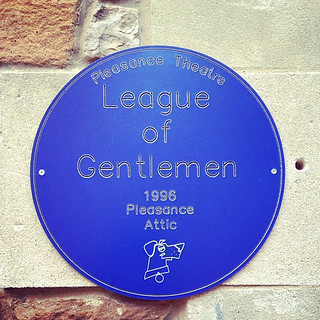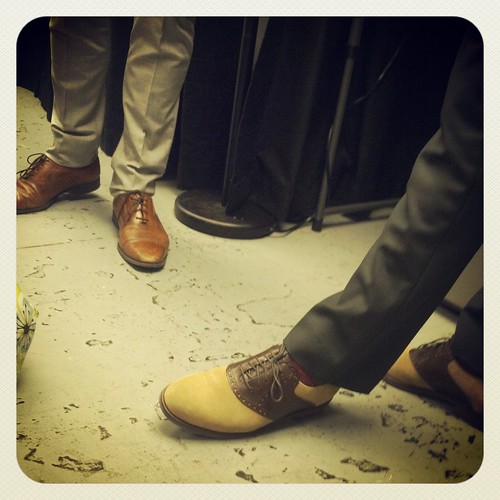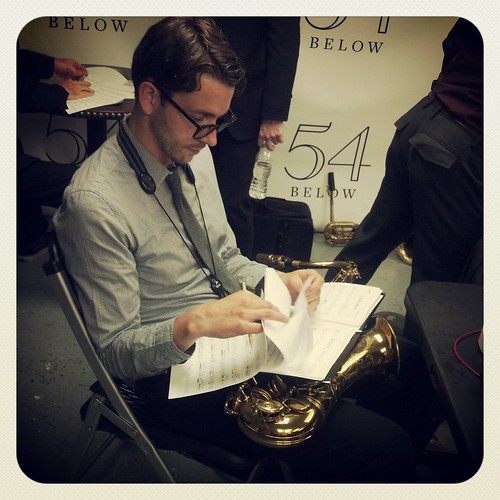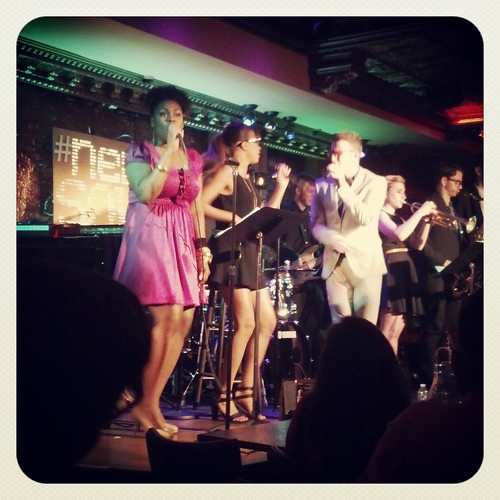
In the past few years, super, super cute, angel-voiced actor AJ Shively has taken big roles both on and off Broadway, in revivals and new works. Currently, he’s starring as bookish, sweet brother Edwin in Carner & Gregor’s Unlock’d for The Prospect Theater Company. While AJ has been keeping busy over at The Duke on 42nd Street, he took some time out to chat with us. Topics covered include advice he’d give to his character Edwin, Saturday nights at the Steak ‘n Shake in suburban Ohio, and 90s cartoon theme songs. Obviously.
Sophie: Ok, so, what drew you to Unlock’d?
AJ: Well, I’ve worked with the writers Sam [Carner] and Derek [Gregor] a few times before, so I knew that the material was gonna be good. And hearing my character’s big song–I just knew I had to sing it; I knew I had to do it. And I have so much respect for Prospect [Theater Company] and Cara [Reichell] and Pete Mills, so it was just a confluence of people who I really admire and it ended up working out for me
S: Is it good to have a relationship with the people involved before you start?
AJ: Yeah, it sets up a nice rehearsal process because you feel comfortable asking questions and they feel comfortable answering your questions. And if you don’t understand it you can be like, ‘Hey I don’t understand what you’re saying,’ and you don’t have to worry about ruffling any feathers because you already have the rapport.
S: Uh, there’s a lot of comedy in the show, which is all about the timing–have there been any brilliant onstage mishaps?
AJ: Oh, man. All the time. There’s moment of the show where Roderick and Edwin exchange scissors and they give each other big bro hugs. Well, the other night my pair of scissors got caught in his sleeve and after we hugged they got knocked clear across the stage. Thankfully not at eye level. So we had to figure out a, an adjustment to the choreography so I could go pick up the scissors, ‘cause, you know, they’re kind of important to the plot. And during the big battle scene I accidentally stepped on the back of one of the ladies’ dresses and they’re all rigged to come off easily for the quick changes, so, half her dress came off. On stage.
S: Oops.
AJ: [laugh] So little things like that happen every now and then. But nothing too terrible. And then there are the wonderful moments when you get tongue-tied, or you talk yourself into a corner and you’re like, oh, that’s not what my line is.
S: If you could give your character Edwin any advice, what would it be?
AJ: Well, I think the advice he gets through the story-line is to “raise your eyes up, look at the people around you, connect with the rest of mankind, cause there’s a lot of valuable things to learn from other people,” so I think that’s what I would say to him at the top of the show. And I guess at the end of the show I would just say keep with it. Just keep going in that direction. And maybe just relax a little bit, have fun.
S: You’ve done both revivals and original work — what do you think is interesting about each of them?
AJ: The major difference in doing a revival is that they’re not fiddling around with the material from the moment you’re cast you can learn your role and it’s not gonna change. So that enables you to show up off book and be ready to play around in the rehearsal room in a different way. Whereas you can do the same thing with a new work but by the second week of rehearsal most of it’s gonna be rewritten anyway. So it’s different parts of your memory, I guess. But ultimately I found I look at every new project as a kind of blank-slate opportunity to figure out maybe, in a revival, something different about the story that hasn’t been on the surface, maybe, in previous incarnations that we can shed some light on.
I enjoy doing them both, though I have a soft spot for watching a new work come together. Taking note of all the changes and figuring out why a song doesn’t work in a certain place or, you know, for Unlock’d, on the last day in the rehearsal room they re-ordered the entire first 15, 20 minutes of the show and it worked so much better. It was all the same material just in a different order. And it’s very interesting to the intellectual side of me, to try and pick apart why it works so much better. I find that really fun. That’s the Edwin in me.
S: So, you were on tour with The Sound of Music when you were very young. Did you always know you wanted to work in theater?
AJ: I love stories and storytelling and I think that’s what the entertainment industry is. From before I can remember I have been a voracious consumer of film, you know, at four years old I discovered the movie Ben Hur and was able to sit down through the entire 3 hours and be captivated by it. But it didn’t really occur to me that I could do it until I was probably 8 or 9 and I saw the national tour of Big and there were boys that were probably 12 on stage doing this play. I had always liked seeing plays but until then I didn’t really connect that I could do it. That’s when I started doing community theatre which, thankfully, led very quickly to The Sound of Music and some real professional experience.
S: How old were you when you did that?
AJ: I was cast I was 12. I turned 13 on the road.
S: Wow.
AJ: Yeah. It was crazy, it was a crazy couple of years to go from being your quintessential suburban Ohio elementary school student who had his piano lessons and was on the swim team, and the soccer team to two years later being on a national tour getting tutored to keep up with my school work and everything.
S: A sort of atypical adolescence.
AJ: Yeah definitely. When child acting slowed down for me it was great to be able to go back to Ohio and I have the experience of going to those giant public schools you see in all the teen films, you know?
S: So when you were 16 you sort of were back in sort of normal public school system and all that?
AJ: Right.
S: What would you have been up to on an average Saturday evening back then?
AJ: Oh man. I guess it depends if I’d been cool enough that week to be invited to anything [laugh]. No, I mean, usually a typical Saturday was just going over to a friend’s house and, and watching movies, and just goofing around. There’s really not that much to do in suburban Ohio so, you know, we’d go loiter in different places. We would just drive to the Steak ‘n Shake and sit in the parking lot, then drive around and come back to the parking to see who was in what car, then drive around again.
S: Sounds brilliant.
AJ: Yeah, very, very exciting.
S: Okay. Lightning round! If you could revive any musical or play for yourself what would it be?
AJ: I wanna play Sweeney Todd so I’ve got some time for that one. But I think that that’s the musical that I would try and get done for myself.
S: What’s your go-to warm up song?
AJ: I don’t know if I necessarily have one. In the dressing room at Unlock’d we’ve been listening to a lot of 90s cartoon theme songs, which has been getting us into the right mood for the show. So, last night we listened to the Gummy Bears theme song and Darkwing Duck. So that’s kind of our warm-up in the dressing room.
S: That is the best answer I’ve ever heard.
AJ: It’s really fun. I mean you can’t help but be in a good mood after listening to a 30-second, nineties-pop, synthesized cartoon jingle.
S: In that case, what’s your favourite mid to late nineties pop song?
AJ: I always liked the Edwin McCain song that goes, “I’ll be your crying shoulder”, but I always thought it was “I’ll be your dying soldier” and I would, like, commit to it and sing it full out in the car and everyone’s looking at me like I was dumb. So, I really liked that and, I don’t know the 90s pop scene kind of flew right by me. I always liked James Taylor and those kind of more folk-rock people. And The Beach Boys. I grew up listening to James Taylor and The Beach Boys.
S: Favorite book when you were a kid?
AJ: There were a lot of them, I read all the time. I really liked the Encyclopaedia Brown books. And I also really, really liked the King Arthur legend. Because that’s what my name is, Arthur Jonathan, that’s what the AJ stands for. And my father is Arthur as well, so we would read the King Arthur books, ‘cause we were Arthurs.
S: What’s your favorite book now?
AJ: My favorite book now–it’s gotta be Stephen King’s Dark Tower Series. I can’t pick one of them but I’m just obsessed. He creates such a vivid landscape, such a vivid cast of characters, you really believe the world exists. You can just lose yourself in the storytelling.
S: Tell us something we don’t know.
AJ: Oh gosh. Uh, I just went to Murray’s Bagels? [laugh]
S: Final question. My editor in New York thinks you sound just like Gavin Creel and she tells me about it all the time. We were wondering, do people say that to you as well?
AJ: Oh wow… No, I’ve not heard that very often, and I take that as a huge compliment so thank you very much. We went to the same school but we had different voice teachers. I don’t know, we’re both Ohio guys who went to Michigan so maybe there’s something in the water.















































